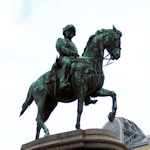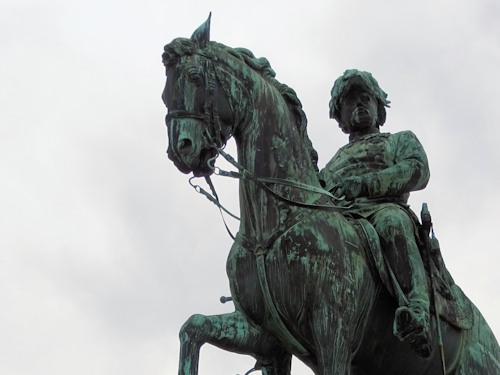
We saw in earlier articles how different terms applied to the group of lands ruled by the Habsburgs. But what about the family members themselves?
- See also:
- Previous: Other Habsburg terms
- Next: k. k. and k. u. k. – what?
It’s all in the title

(Kaiser Franz Joseph, he of many titles. Photo courtesy of the Library of Congress)
No self-respecting scion of the royal dynasty would be seen out in public without their official title. But where exactly do the terms Emperor and Empress or Archduke and Archduchess fit into Habsburg and Viennese history?
Your typical Habsburg monarch had a lot of titles. A lot.
Emperor Franz Joseph (1830-1916), for example, preceded one 1848 proclamation with a list that included:
Emperor of Austria; King of Hungary and Bohemia, King of Lombardy and Venetia, of Dalmatia, Croatia, Slavonia, Galicia, Lodomeria and Illyria; Archduke of Austria; Grand Duke of Tuscany; Duke of Lorraine, of Salzburg, Styria, Carinthia, Carniola; Grand Duke of Transylvania; Margrave of Moravia…and we’re not even close to finishing the list.
His business cards must have been A4 format.
But you shouldn’t worry about all those different titles. You really only need to understand two when visiting Vienna: Emperor/Empress and Archduke/Archduchess.
Emperor/Empress
(German: Kaiser / Kaiserin)

(Johann Hieronymus Löschenkohl (publishing house); Emperor Franz II. as he was known from 1792 to 1806 and Emperor Franz I. as he was known from 1804; Wien Museum Inv.-Nr. 90518; excerpt reproduced with permission under the terms of the CC0 licence)
Nearly all the famous Habsburgs you’ll come across were Emperors or Empresses, either in their own right or as the spouse of the ruler.
They weren’t all Emperors of the same thing, of course. Earlier Habsburg emperors (pre-1806) got that title as formal head of the Holy Roman Empire. After 1804, they got it as head of the Austrian Empire.
Franz (1768-1835) was the lucky Habsburg who got to be a double emperor between 1804 (the official founding of the Austrian Empire) and 1806 (the dissolution of the Holy Roman Empire).
He was Emperor Franz II (Holy Roman Emperor) and also Emperor Franz I (Austrian Emperor). That’s why you often see him referred to as Franz II/I or Franz I/II, for example.
The numbers attached to the name obviously depend on how many previous holders of the title shared that same name. This sometimes gets confusing. As with Franz above, the number depends on which title you’re currently talking about.
Back in the 15th century, for example, the Habsburg monarch Frederick (1415-1493) was Frederick III, Frederick IV and Frederick V, depending on whether you were referring to his position as Holy Roman Emperor, King of the Romans or local Duke. Fun for him, confusing for the rest of us.
In general, though, the Roman numerals following the names of Habsburg rulers refer solely to their status as Emperor.
Archduke / Archduchess
(German Erzherzog / Erzherzogin)

(Statue of Archduke Albrecht)
Spend much time in Vienna and you’ll start to think the place was largely populated by Archdukes (male) and Archduchesses (female). They’re mentioned everywhere.
For example:
- The statue in front of the Albertina palace and art museum is of Archduke Albrecht (1817 – 1895)
- The collection of paintings in the Kunsthistorisches Museum owe much to the collecting efforts of Archduke Ferdinand II. (1529 – 1595) and Archduke Leopold Wilhelm (1614 – 1662)
- Empress Elisabeth (1837 – 1898) was known for her battles with Archduchess Sophie (Emperor Franz Joseph’s mother).
You get the picture.
This title was almost exclusively a Habsburg one. The family invented it for themselves by, for example, turning the Duchy of Austria into the Archduchy of Austria (so the monarch carried the title Archduke or Archduchess of Austria).

(Maria Theresa, Archduchess of Austria, Queen of Hungary & Bohemia, and Holy Roman Empress. Image courtesy of the Rijksmuseum)
At some point, the sons and daughters of the Emperor/Empress also received the title Archduke or Archduchess. Now you can see why there are so many; Maria Theresa (1717-1780) had 16 children, for example.
(One of these children was Archduchess Maria Antonia, who married the future Louis XVI of France and became Marie Antoinette.)
Incidentally, the immediate heir to the throne (and their consort) was also the Kronprinz or Kronprinzessin (crown prince/princess).
So, for example, Emperor Franz Joseph and Empress Elisabeth had four children:
- Archduchess Sophie Friederike
- Archduchess Gisela
- Crown Prince and Archduke Rudolf
- Archduchess Marie Valerie
But our struggles with titles do not end there. We have one more kind worth knowing about. Not titles for a person, but an organisation.
A fair few stores and old signs in Vienna’s centre carry the moniker k. u. k. or k. k. along with the implication of some significant royal connection. But what does it stand for? Here’s the explanation.